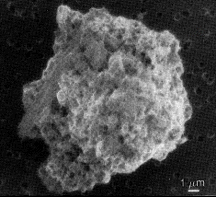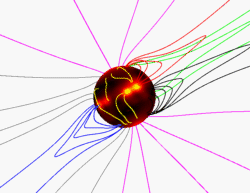ExploraTour: A Peek into the Lives of the Stars
Click on image for full size
Prof. Robert Walker, McDonnell Center for the Space Sciences, Washington University, St. Louis, MO
Where are Stars Born?
New stars are formed in clouds of gas and dust that are in outer space between the stars.
If you're picturing a dense fog cloud, think again. Typically in a dust cloud, you would have to search long and hard to find a single dust grain in a space the length of a football field on each side.
And then the dust grain is very small. About 4000 dust grains could fit across a sucker stick.
But dust clouds in space are incredibly large. A typical cloud contains about 8 million trillion trillion trillion trillion tiny dust particles.
The picture on the left shows a dust particle from outer space, which researchers have named Florianus. The dust particle is so small we could not see it with only our eyes. It was collected by a high-flying airplane in our own atmosphere.
Dust grains like this become part of new stars.












